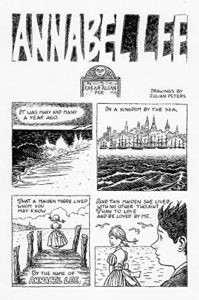Comic artist Julian Peters is inspired by great poetry, and for a specific reason. Poetry, he writes, shares common characteristics with comics — the notion of rhythm, repetition of visual elements, and the use of juxtaposition, to mention three. That’s what poetry and comics have in common, but Peters wanted to go beyond what he saw as obvious.
It was the love of beauty, the beauty inherent in great poetry, that led him to visualize what that poetry might look like in comic art. So he set out to “translate great poems into the visual language of comics.” The result is Poems to See By: A Comic Artist Interprets Great Poetry.

Peters has assembled 24 poems and organized them into six “seeing” categories — yourself, others, art, nature, time, and death. The poems are all well known, including “‘Hope’ is the thing with feathers” by Emily Dickinson, “The Darkling Thrush” by Thomas Hardy, “The World Is Too Much With Us” by William Wordsworth, and “Annabel Lee” by Edgar Allan Poe. The text of the poems are including in the drawings, and then the poem in its entirety follows.

A drawing from “Annabel Lee”
“Annabel Lee” becomes the story of young love between a boy and a girl. Maya Angelou’s “Caged Bird” becomes the presentation of a patchwork quilt. One of the most haunting presentations is “Conscientious Objector” by Edna St. Vincent Millay. Peters draws all of the human characters with skulls for faces, with the exception of the narrator/poet, vividly bringing the meaning of the poem alive.
If I have a favorite in the book, it’s “Buffalo Dusk” by Carl Sandburg. Peters overlays drawings of buffaloes and buffalo herds on shopping center parking lots, freeway overpasses, subdivisions, and business districts, punching home Sandburg’s point of the passing of the buffalo and the passing of what was once America.

Julian Peters
Peters is a comic book artist and illustrator who in recent years has begun to focus his work on poetry. His master’s degree in art history included a thesis on two graphic novels. He says his favorite artist is Aubrey Beardsley, and his favorite poets are T.S. Eliot, Arthur Rimbaud, and William Butler Years. He lives in Montreal.
Poems to See By demonstrates how an artist’s understanding and interpretation of a poem can both communicate what the poem is about and provide a way to grasp it. It’s no wonder his works are often used in classrooms — visually teaching well-known poetry.
Related:
Poems to See By: Video of Invictus by William Ernest Henley (illustrated by Julian Peters)
Photo by Ryan-o, Creative Commons, via Flickr. Post by Glynn Young.
__________________________

“I require all our incoming poetry students—in the MFA I direct—to buy and read this book.”
—Jeanetta Calhoun Mish
- Poets and Poems: Beth Copeland and “I Ask the Mountain to Heal My Heart” - July 10, 2025
- A.E. Stallings: the Parthenon Marbles, Poets, and Artists - July 8, 2025
- Poets and Fables: Steven Flint and “The Sun and the Boy” - July 3, 2025

Megan Willome says
Oh, Glynn! This book is built for me. Over the last year or so I’ve been frequenting the section of my library with illustrated poetry, usually meant for children, but I get so much out of it. It must be the picture book-lover in me.
I’m really intrigued with that Carl Sandburg because I recently finished an illustrated version of his poems, which will be in Friday’s Ritual to Read list.
Glynn says
Megan, each of the comic art treatments almost forces you to look at the poems in a different way.
Maureen says
I think I might send a copy of Peters’s book to my son, who is working on a story, which will be translated into a graphic book and also set to music. The story line is complicated (it’s something to hear him relate progress on it, and the number of characters involved).
I love how creative the form is and what comes out of it.
Glynn says
Peters has illustrated a number of graphic novels. It’s a form I’ve generally not followed or read, but I did love the Classics Illustrated comic books.
Sandra Heska King says
I need to order this for the grand girls. And one for myself.
Bethany R. says
Isn’t this cool, Sandra? Going to check it out too. 🙂
Thanks for this, Glynn!